
| Manufacturer: | Philips |
| Model: | Master PL-C 10W 827/2P Ecotone |
| Application: | General Lighting |
| Wattage: | 10W |
| Diameter (max): | 33mm |
| Length: | 118mm |
| Tube Length: | 300mm approx |
| Bulb/Tube material: | Glass. Colour 827 phosphor coating on inner surface |
| Colour Temperature: | 2700K |
| Peak output wavelength: | N/A - Broadband emission. |
| Total light output: | 600Lm (60Lm/W) |
| Rated lifetime: | 10'000 Hours |
| Cap: | G24d-1 |
| Operating voltage: | 64V |
| Operating current: | 190mA |
| Warmup/restrike time: | 1 minute/none |
| Cost (original): | £4.97 for lamp, ballast and fitting (table lamp) from Tesco Supermarket. (Jan 2006) |
| Place of manufacture: | China |
| Date of manufacture: | April 2005 (Code D5). |
| Lamp Status: | Working |
Well, this was a first for me...first time I've ever bought a complete lighting fixture just because I wanted the lamp! This was spotted in our local Tesco supermarket. A complete table lamp, complete with the PL-C lamp pictured here and a ballast unit...all for a few pence short of £5. The package consisted of a small wooden based table lamp, the PL-C lamp itself, and a magnetic ballast built into a somewhat large plug in unit, similar to the type commonly containing low voltage power supplies.
This lamp is one of Philips' extensive PL range of non-retrofit compact fluorescent lamps. When compact fluorescent lamps started to become a common sight, Philips were the first to spot the idea that the lamps need not be directly connected to the ballast as with the type of lamps you see designed to replace conventional incandescent ones. This meant that a whole new world could be opened up to the designers of the opportunity to use these extremely compact lamps in applications where previously only miniature fluorescent tubes or incandescent lamps could have been used. The PL series are available in a variety of styles, the PL-C as shown here, a two-tube version in high and low wattages (The PL-L and PL-S respectively), a recently launched high output version in wattages of up to 120W (PL-H), a version making use of U shaped tubes rather than the linear ones here, the PL-T, and even a special version of the PL-L designed for use in low temperature environments. All of these are available in both 2 and 4 pin versions - the significance of this is explained below.
This lamp is fitted with a G24d cap - which will look exceedingly odd to you if you've not seen one before! The two pin cap on this lamp contains a conventional glow-bottle starter and RF suppression capacitor in the square section. This has the added advantage that a new starter is fitted with each lamp - an important feature as the cycling as the end of lamp life when connected to a magnetic ballast is very hard on a starter, and a faulty starter could end up sticking and destroying a perfectly good new lamp. It also has the potential to cause ballasts to overheat and fail. The fitment of a new one with each lamp negates this problem entirely however. Having the starter and capacitor wired internally into the lamp does preclude this from operation on electronic control gear though. It was for this reason that four pin versions of the various lamps were released a few years later, with direct connections to each of the lamp electrodes, and no internal starter.
The unusual straight four tube design of this lamp (and others in this range) is one of my favourites when it comes to lamp design, not least because it was one of the first that I started seeing. It does help in functional terms too, due to one of the characteristics of fluorescent lamps (and in fact all metal vapour lamps). The efficacy of these lamps is determined by the vapour pressure in the lamp, this in turn is determined by the temperature of the coldest point on the lamp wall - as the metal dose will condense there. In the case of a low pressure mercury vapour lamp such as this, a low vapour pressure is desirable - hence as low a cold spot temperature as possible is desirable. In the case of this style of lamp, that cold spot is created by leaving a small dead space at the end of each of the parallel tubes. Due to the fact that this area is not part of the path followed by the discharge - hence it is further from the centre of the discharge column, the wall temperature is far lower than anywhere else. This is a simple idea to implement, and works very well for small lamps such as this. Unfortunately on higher wattage lamps, this dead space needs to be quite large due to the higher temperatures present, meaning that the lamps tend to be slightly longer than those using other methods to control vapour pressure such as external amalgams. The ability to control the cold spot temperature like this however does lend a certain flexibility to lamp designers though, in that they can alter the size of the dead space at the end of the tubes to aim for the correct vapour pressure to be achieved at different ambient temperatures. The PL-L range for instance has a smaller dead space at the ends of the tubes, allowing it to operate best at lower ambient temperatures. At the time of writing, Philips PL-L lamps were used in the Clear Channel Landmark bus shelters in Aberdeen City Centre for their night time illumination.

Philips Master PL-C 10W 827/2P Ecotone Compact Fluorescent Lamp - General overview of lamp
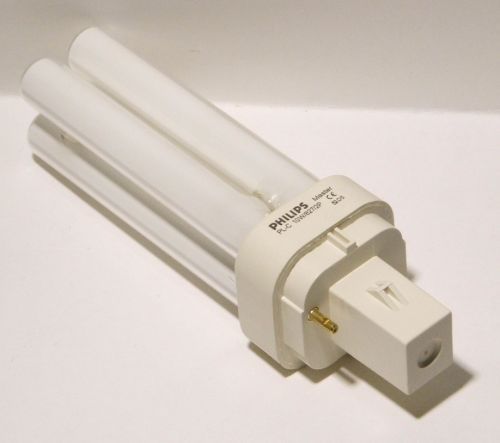
Philips Master PL-C 10W 827/2P Ecotone Compact Fluorescent Lamp - Detail of lamp cap

Philips Master PL-C 10W 827/2P Ecotone Compact Fluorescent Lamp - Detail of tube interconnects
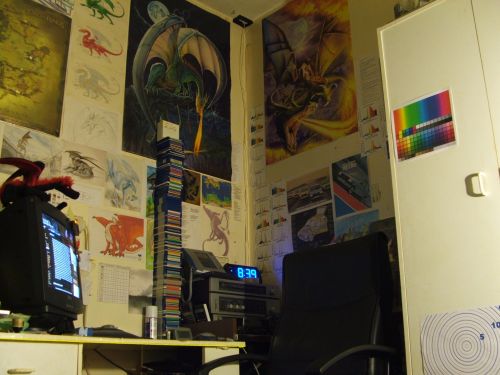
Philips Master PL-C 10W 827/2P Ecotone Compact Fluorescent Lamp illuminating my workstation from a distance of approximately two metres

Philips Master PL-C 10W 827/2P Ecotone Compact Fluorescent Lamp - Overview of lamp shown while lit
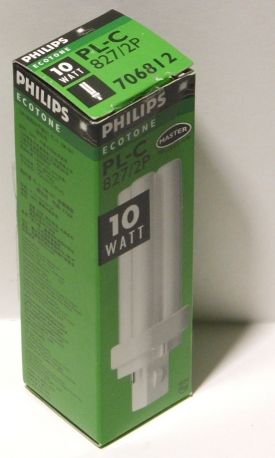
Philips Master PL-C 10W 827/2P Ecotone Compact Fluorescent Lamp - Overview of lamp packaging
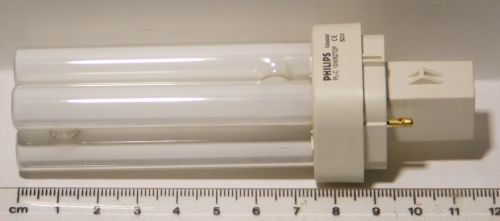
Philips Master PL-C 10W 827/2P Ecotone Compact Fluorescent Lamp - Shown next to a ruler for scale

Philips Master PL-C 10W 827/2P Ecotone Compact Fluorescent Lamp Output spectra
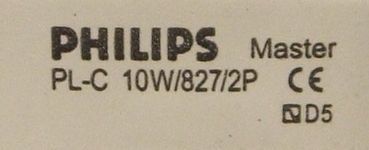
Philips Master PL-C 10W 827/2P Ecotone Compact Fluorescent Lamp - Detail of text printed on lamp base
This lamp added to the Virtual Display Shelf on the 29th January 2006 at 20:52.
References: Manufacturers Datasheets.
Acknowledgements: None.
This page was last updated on 15th June 2023: Page formatting changes to improve readability on mobile devices and some background page code changes to improve search engine behaviour.